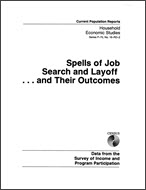Spells of Job Search and Layoff...and Their Outcomes
Spells of Job Search and Layoff...and Their Outcomes
Introduction
This report presents an analysis of the spells of job search and layoff that began in 1984 and the outcomes of those spells. The data provide a rare glimpse of some of the characteristics of these spells—who experienced them, how long they lasted, whether health and unemployment insurance coverage was in force—and their outcomes—how many ended as a result of a job or by a withdrawal from the job market. As was reported by the Bureau of Labor Statistics (BLS), the Nation's economy during this period was still recovering from the 1981-82 recession and employment was growing vigorously and unemployment was dropping sharply.1
The data on spells of job search and layoff discussed here are different from the official unemployment data reported by the BLS. The BLS data are cross-sectional, that is, they indicate how many people were unemployed at a point-in-time. Embodied in that estimate are the persons who have just entered and exited the unemployment pool as well as those who remained unemployed. The data on spells of job search and layoff discussed in this report are longitudinal. They relate to the experience of the same people through time, that is, from the time they began looking for work or periods of layoff to their completion of the spells of job search or layoff.
The distinction between these two types of data is an important one. With the official unemployment data, it is difficult to observe changes in the economic welfare of the same individuals that may take place during a period of job search or layoff. Similarly, it is difficult to observe the outcomes of spells, that is, whether individuals either found or returned to jobs or withdrew from the labor force. With longitudinal data, these and other matters associated with the spell of job search or layoff can be examined.
The source of the data on spells of job search and layoff examined in this report is the 1984 panel of the Survey of Income and Program Participation (SIPP), a longitudinal survey of approximately 2 1 /2 years duration. Although the primary purpose of this survey is to collect information on the incomes received by individuals and the extent to which they participate in Federal government transfer income programs, it also collects information on labor force activity. The linkage of the labor force data to the income and program participation data in a longitudinal context make them particularly useful for examining such subjects as the economic welfare of persons looking for work and on layoff from jobs.
The BLS's employment and unemployment statistics are the Federal government's official estimates and they are collected in the monthly Current Population Survey (CPS). This survey has provided policy makers and researchers with monthly labor force information since the 1940's. In addition, in the March CPS, supplemental questions are asked about the annual work experience of individuals in the previous calendar year. Labor force data from SIPP can enhance what we have learned from both the monthly and March CPS supplement, and it is in this context that this report should be viewed. Differences in labor force concepts and survey procedures exist between the SIPP and CPS, so data comparability is problematic. Furthermore, since the SIPP sample is considerably smaller than the CPS, the data results are subject to greater sampling variability.
_______________
1 See Richard Devens, Jr., Carol Boyd Leon, and Debbie Sprinkle, "Employment and Unemployment in 1984: A Second Year of Strong Growth in Jobs," Monthly Labor Review, February, 1985, pp. 3-15.
Others in Series
Publication
Publication
Publication






